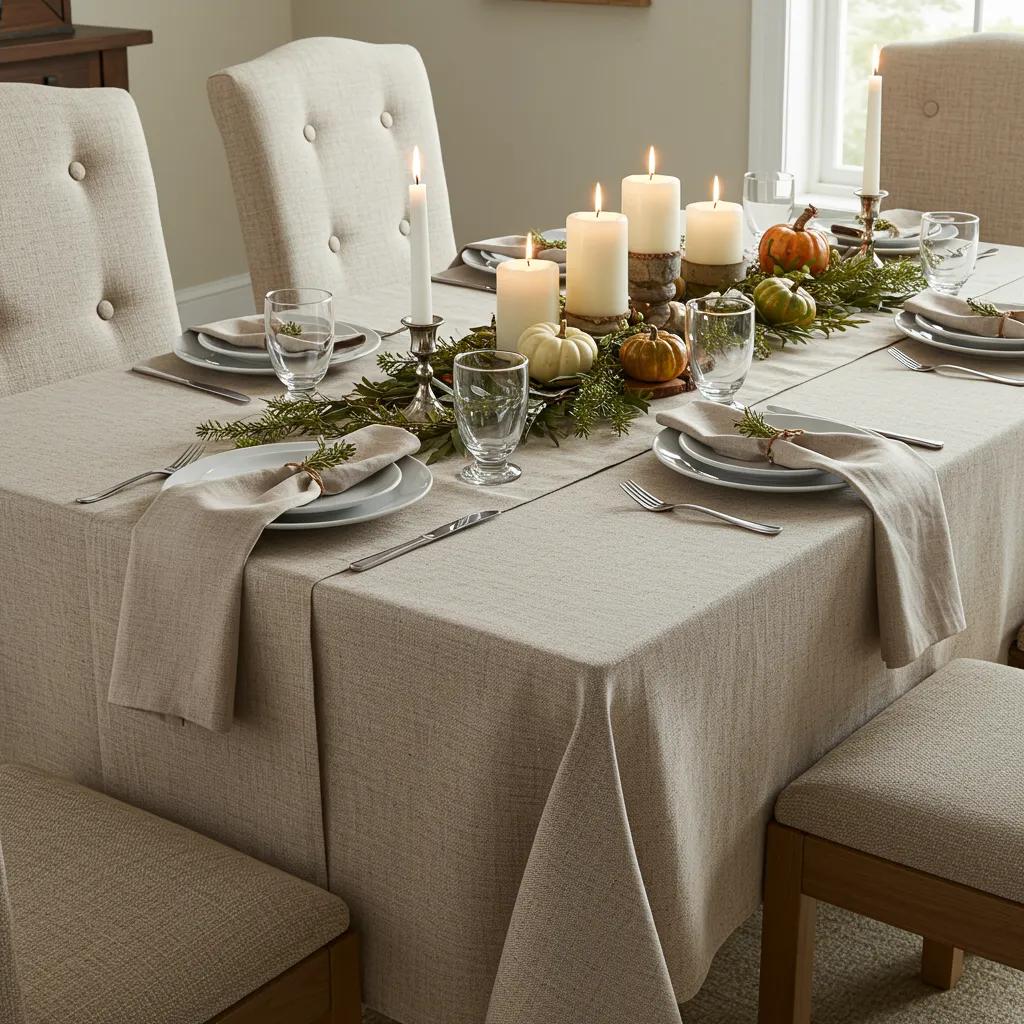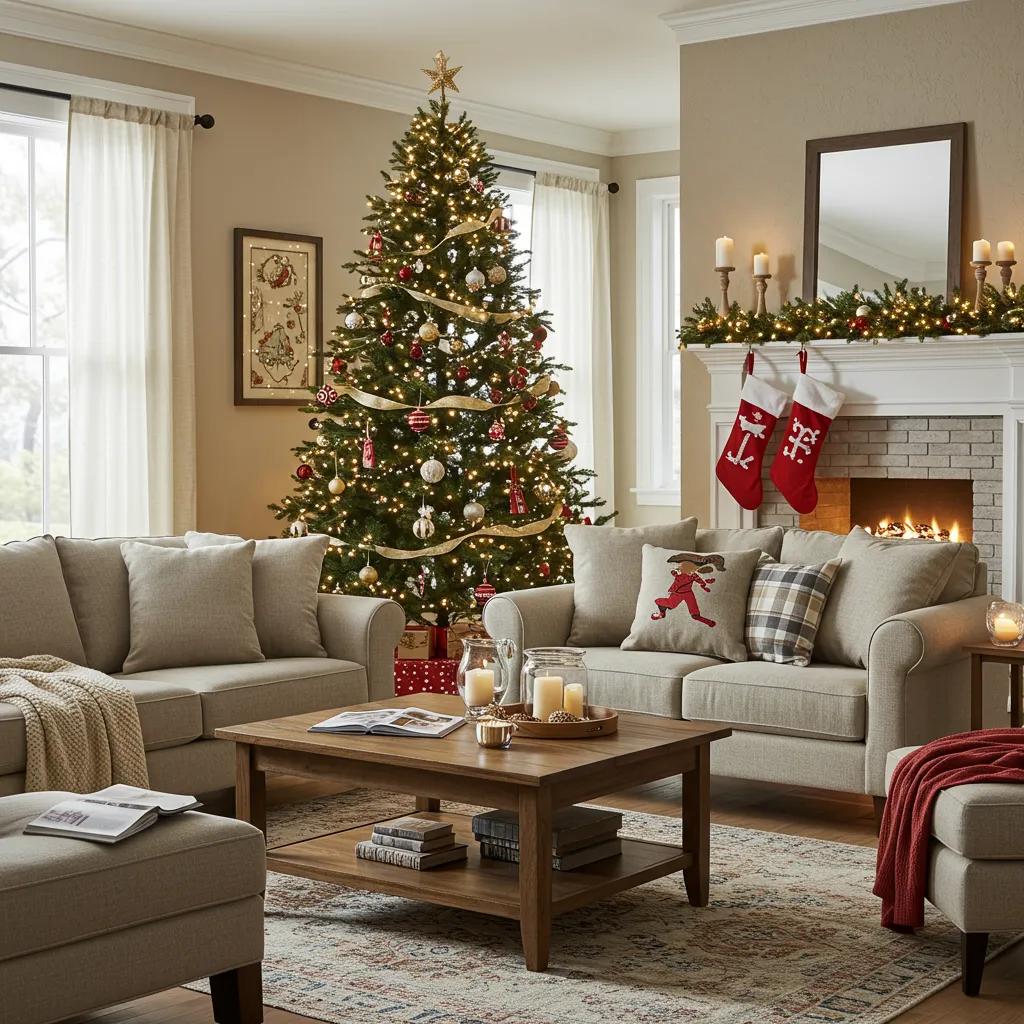Holiday-Ready Homes: Simple Decorating Ideas to Welcome Guests This Season

A holiday-ready home feels warm, welcoming, and intentionally prepared for visitors, and this article shows practical, budget-friendly ways to achieve that feeling from fall through winter. You’ll learn guest-first decorating strategies that prioritize first impressions, comfort, and easy transitions between Thanksgiving and Christmas, including entryway refreshes, table-setting techniques, mantel and tree tips, and quick room-by-room hacks. Holiday home decor here means purposeful choices—layered textiles, ambient lighting, natural elements, and small personal touches—that improve guest experience without a major overhaul. Many hosts struggle with limited time, tight budgets, or how to reuse decor between holidays; this guide promises step-by-step DIYs, sustainable sourcing ideas, and trend-led inspiration for 2025 so you can prepare efficiently. The article maps practical sections: creating a warm atmosphere for guests, budget-friendly Thanksgiving projects, cozy Christmas ideas, rapid hacks for busy hosts, guest-space prep, 2025 trends, and seamless fall-to-winter transitions, each with short how-to lists and comparison tables to help you choose projects. Read on to gather quick wins and longer projects that fit your schedule and style, starting with the elements that shape first impressions at the door.
How Can You Create a Warm and Welcoming Holiday Atmosphere for Guests?
Creating a warm holiday atmosphere centers on layered sensory cues—clean, uncluttered entryways, textured textiles, layered lighting, and subtle seasonal scents—all working together to make guests feel seen and comfortable. These elements function because first impressions set expectations: a tidy, decorated entry signals hospitality, cozy textiles invite lingering, and warm lighting reduces tension and creates intimacy. The benefit is a guest experience that feels effortless to you but intentional to visitors, encouraging relaxation and conversation. Start by focusing on a few high-impact swaps that are easy to revert, then move into room-specific tactics like entryway decor, textiles, and nostalgic natural touches that carry warmth across the house.
What Simple Decor Elements Instantly Make Your Entryway Festive?
A festive entryway relies on a clear focal point, layered lighting, and a brief decluttering routine to welcome guests effectively. A focal wreath or seasonal door hanging anchors the space and signals the season; adding a weatherproof doormat and a small bench or tray for keys creates instant functionality. Soft outdoor lighting—lanterns or string lights placed safely—extends welcome after dusk while a small grouping of potted seasonal plants or stacked pumpkins adds natural texture. Quick DIY tips include tying a ribbon to an existing wreath, swapping seasonal doormat covers, and placing a tray with guest essentials, all of which take under 20 minutes to execute and prepare the visitor path before they enter.
The initial impression of a home's entrance is crucial for setting a welcoming tone.
Designing Welcoming Entryways for Visitors
While certain graphical elements are essential, our design approach emphasizes A Sense of Entry: designing the welcoming school, 1989
How Do Cozy Textiles and Lighting Enhance Holiday Ambiance?
Textiles and lighting transform temperature perception and social behavior by adding visual warmth and softening acoustics—throws and pillows reduce echo while layered lighting shapes mood. Choose a neutral base of linens and rugs, then introduce seasonal accents like rust-orange throws or plaid pillows for fall and deeper greens or velvet for winter; these swaps offer immediate impact without replacing core pieces. Lighting should consist of ambient overhead or diffused lamps, task lighting for reading or serving, and accent lights such as LED candles or string lights to create pockets of warmth.
An example living-room setup pairs a textured wool throw on the sofa, two accent pillows, a table lamp for task light, and a string of warm LED lights across shelving to invite guests to sit and stay awhile.
Which Natural and Nostalgic Decor Items Add Seasonal Charm?
Natural and nostalgic elements—pinecones, branches, small gourds, heirloom ornaments, and vintage linens—add texture, scent, and emotional resonance, making spaces feel personally curated rather than commercially staged. Foraging for branches and pinecones or rescuing vintage napkins from a thrift find connects the season to memory and sustainability, and these pieces can be reused across years for continuity. Repurpose jars as candle holders, bundle dried herbs for simple sachets, or display a collection of heirloom ornaments on a tray to create a sentimental focal point. Sourcing tips include checking local markets and backyard foraging where legal, then combining these finds with modern containers to balance nostalgia with contemporary styling.
What Are Easy and Budget-Friendly Decorating Ideas for Thanksgiving?
Thanksgiving decorating prioritizes a welcoming table and a hospitable porch that say "stay and eat" without extravagant spending; focus on layering, natural centerpieces, and repurposing elements you already own. The mechanism for impact is contrast—pair everyday plates with seasonal textiles, add a focal centerpiece built from foraged greens and candles, and use groups of similar items (pumpkins, gourds, jars) to amplify presence without many purchases. The result is an elegant, inviting tablescape and entry that feels rich and abundant but is reachable on a budget. Below are clear how-to lists and a comparison table to help you pick centerpieces based on cost, time, and material needs.
How Do You Set an Elegant and Inviting Thanksgiving Table?

An elegant Thanksgiving table balances practicality and beauty by using layers, a low central focal point, and accessible guest settings that promote conversation. Layer a neutral base cloth with a seasonal runner, then arrange chargers or oversized placemats to anchor each place; fold napkins simply and add a small decorative element like a sprig of greenery or a mini gourd to personalize settings. For centerpieces, keep height low—use a runner of greenery with interspersed candles or a line of small vases—so guests can see each other across the table. Finish with practical touches such as a water carafe, accessible condiments, and small bowls for shared items; this approach keeps the table beautiful and functional for hosting.
What DIY Thanksgiving Centerpieces Can You Make with Natural Elements?
DIY centerpieces using foraged or low-cost materials create a rich harvest look with minimal expense and clear steps for repeatability. One idea is a tiered candle tray: layer a wooden board with varying candle sizes, tuck in sprigs of evergreen and dried grasses, and add small gourds to the corners for color contrast. Another project uses hollowed mini pumpkins as bud vases—cut tops, remove seeds, and place a small glass vial with water and a single seasonal bloom. A third option creates a runner of eucalyptus and seeded branches woven around battery-operated candles for safety; each project requires about 20–40 minutes and common materials, making them ideal for last-minute prep.
Use this table to quickly compare centerpiece styles by cost, time required, and primary materials so you can pick the best fit for your budget and schedule.
| Centerpiece Style | Estimated Cost | Time Required | Key Materials |
|---|---|---|---|
| Tiered Candle Tray | Low ($10–$25) | 20–30 minutes | Candles, wooden board, greenery |
| Mini Pumpkin Vases | Low ($15–$30) | 30–45 minutes | Mini pumpkins, small vials, flowers |
| Greenery Runner | Low–Medium ($10–$40) | 25–40 minutes | Eucalyptus, seeded branches, LED candles |
How Can You Decorate Your Front Porch for a Cozy Fall Welcome?
A cozy front porch balances durability with seasonal style—use weatherproof textiles, secure greenery, and layered lighting to create a warm, safe welcome that lasts through Thanksgiving weather. Group potted mums or evergreen planters near the door, stack a few pumpkins at different sizes, and add a sturdy outdoor rug for texture and warmth underfoot. For lighting, use battery-operated lanterns or weatherproof string lights placed safely away from flammable materials; secure all hanging decor against wind and moisture. A quick maintenance note: choose materials that tolerate damp conditions and fasten items securely to avoid safety hazards, then you can transition these same groupings into winter with simple swaps.
How Do You Decorate Your Home for a Cozy and Festive Christmas Season?
Christmas decorating combines focal updates—mantel, tree, and living room—with practical layering to create a cozy festive environment that prioritizes guest comfort and ease of entertaining. The mechanism is cumulative: small, cohesive choices across multiple surfaces—mantel garlands, soft textiles, and balanced tree decoration—compile into a warm, immersive feel for visitors. Benefits include a home that invites lingering, supports conversation, and makes hosting simpler because the visual rhythm is consistent across rooms. Below are practical mantel, living room, and tree strategies that are easy to implement and adaptable to different styles.
What Are Simple Christmas Mantel Decorating Ideas?
The mantel functions as a holiday anchor point; styling it with garland, candles, and a mix of sentimental and new pieces creates a balanced focal display. Three styling formulas work well: minimal (single garland and a pair of pillar candles), traditional (greenery, stockings, and mixed ornaments), and maximal (layered garlands, framed vintage prints, and clustered ceramics). Materials lists should include garland (real or faux), a variety of candle heights, and small personal items like ornaments or framed photos to integrate nostalgia. Quick assembly steps: drape garland with secure ties, place candles at differing heights, and finish with one striking central piece—this produces a finished mantel in under 30 minutes.
How Can You Create a Cozy Christmas Living Room?

A cozy Christmas living room emphasizes conversational seating, accessible surfaces for drinks and plates, and tactile textiles that invite guests to unwind and stay longer. Swap lightweight throws for heavier woven blankets, add plush pillows with seasonal textures, and create seating clusters by arranging chairs and sofas to face each other with a coffee table in between for shared platters. Lighting should combine a warm overhead setting with floor or table lamps for task light and accent lights such as string lights or LED candles for atmosphere. These changes both improve function for hosting and reinforce a consistent holiday style across living spaces.
What Are Easy Tips for Decorating a Christmas Tree Beautifully?
Decorating a Christmas tree beautifully starts with lights first—string warm LED lights evenly through branches from trunk to tip to create depth—then add garlands and ornaments with attention to proportion and color cohesion. Cluster ornaments in groups of three and mix matte, shiny, and textured finishes to avoid flatness; use larger ornaments toward the center and smaller ones at the tips to maintain balance. For small spaces, select a slim tree or tabletop option and prioritize vertical decoration and layered lighting to maximize visual impact without taking up floor space. Final touches like a simple tree skirt or a handful of wrapped boxes beneath the tree complete the vignette and signal readiness for guests.
Compare tree decorating styles by difficulty, time required, and best rooms to understand which approach suits your home and hosting needs.
| Tree Decorating Style | Difficulty | Time Required | Best Rooms |
|---|---|---|---|
| Minimal Chic | Easy | 30–60 minutes | Entry, small living rooms |
| Traditional Plenty | Medium | 1–3 hours | Main living/dining rooms |
| Practical Maximalism | Medium–Hard | 2–4 hours | Large family rooms |
The choice between natural and artificial Christmas trees is a significant one for many households, impacting both aesthetics and producer income.
Natural Versus Artificial Christmas Trees: Household Decoration Behavior
Christmas is a globally significant occasion, with millions of trees decorated annually to evoke the Christmas spirit. The cultivation of tree varieties specifically for Christmas decoration can be a profitable agricultural endeavor. While both natural and artificial trees are available in the market, producers in Greece experience very low demand for their natural products due to intense competition from artificial alternatives. Consequently, understanding household behavior concerning Christmas tree decoration and tree type choice is crucial as it directly impacts producers' annual income. This article presents the findings of research investigating consumers' Christmas tree decoration behavior. Specifically, it examines whether households decorate a tree for Christmas, the type of tree decorated, and the rationale behind choosing a natural or artificial tree. Furthermore, it explores the influence of the household head's age on tree decoration behavior. The study utilized a sample of 962 households in the greater Thessaloniki area, Greece, employing the mall intercept technique.
Natural vs. Artificial Christmas Trees: Age effects on households decoration behaviour, D Arabatzis Garyfallos, 2010
What Are Quick and Practical Holiday Decorating Hacks for Busy Hosts?
Busy hosts benefit from high-impact swaps and reusable strategies that shift mood quickly without intensive effort; this relies on prioritizing visible zones, reusing decor across rooms, and choosing multipurpose items. The mechanism for efficiency is triage—focus on entry, living, and dining first, then add accents in other rooms only if time allows—to ensure guests encounter warmth immediately. Results are faster setup, less stress, and a cohesive look that feels intentional rather than hurried. Below are time-saving lists and DIY economy ideas to get multiple rooms holiday-ready in hours.
- Swap Pillows and Throws: Replace a couple of accessory pillows and add a textured throw to the sofa for instant seasonal warmth.
- Switch Table Linens: Add a runner or seasonal napkins to the dining table to create a finished look.
- Add Candles or LED Lights: Place flameless candles or strings in key zones for immediate ambiance.
These swaps are fast to execute and pave the way for DIY wreaths and ornaments to extend your budget further.
Which Affordable Decor Swaps Make a Big Seasonal Impact?
High-impact swaps work because they change the room's focal points and tactile cues—textiles and lighting alter how spaces feel immediately while small accent changes reset color stories. Simple swaps include changing cushion covers to warm tones, replacing a living-room centerpiece with seasonal fruits or greenery, and using a runner on the dining table. Cost estimates are low: pillow covers or a runner often under a modest budget, while LED candles are reusable across seasons. Prioritize visible areas—entryway, main seating, dining—and these inexpensive swaps will make the home feel updated without a large investment.
How Can You Use DIY Holiday Wreaths and Ornaments to Save Money?
DIY wreaths and ornaments save money by using readily available materials like wire frames, foraged greens, scrap fabric, and repurposed baubles, and they allow creative personalization to match your home’s palette. Mini-projects include a simple wired wreath wrapped in eucalyptus, a group of fabric-wrapped ornaments using leftover cloth and ribbon, and painted pinecones for tree accents or place settings; each project takes 20–45 minutes and minimal tools. Safety notes: use battery-operated lights with wreaths and avoid open flames near dried materials. These handmade pieces also double as meaningful gifts or keepsakes, amplifying their value beyond cost savings.
What Are Time-Saving Tips for Decorating Multiple Rooms?
When decorating multiple rooms, adopt a staged timeline and reuse versatile elements to keep effort proportional to impact and avoid duplication of work. Create a 2–3 hour plan focused on entry, living, and dining with a simple checklist; reserve a half-day for a fuller refresh including mantel and porch, and a full-day for complete tree decorating and deeper projects. Pack decor by room during storage to speed setup, and use multipurpose items—garlands, candles, and cordless lights—across spaces to maintain cohesiveness. This task-based approach reduces decision fatigue and ensures that the most important guest-facing rooms are prioritized first.
How Can You Prepare Guest Spaces to Make Visitors Feel Comfortable This Holiday Season?
Preparing guest spaces means focusing on practical comfort—layered bedding, accessible lighting, clear luggage space, and thoughtful amenities—so visitors feel cared for without requiring constant host attention. The mechanism is anticipatory hospitality: small, meaningful touches remove friction for guests and improve their experience, from charging access to a bedside water carafe. Benefits include guests who rest better and feel attended to, freeing hosts to entertain without interruption. Below are essential checklists, a comparison table for guest-room touches, and bar cart styling tips that balance function and festivity.
Essential guest bedroom touches fall into bedding, convenience, and welcome items to ensure restful stays and easy orientation for visitors.
- Layered Bedding: Provide a base sheet, duvet/comforter, and an accessible throw to accommodate temperature preferences.
- Offer Practical Conveniences: Ensure bedside lighting, accessible outlets, and a luggage rack or cleared surface.
- Add Welcome Touches: Place a small tray with a water bottle, a snack, a map/local suggestions, and a neutral-scented toiletry sample.
These basics create a comfortable, guest-ready room; next is a detailed table listing options and benefits.
Compare guest-room touches with their benefits and practical examples so you can prioritize preparations quickly.
| Guest Touch | Benefit | Example/Setup |
|---|---|---|
| Layered Bedding | Temperature flexibility | Duvet + extra throw on foot of bed |
| Accessible Power | Convenience | Nightstand with power strip and USB ports |
| Welcome Tray | Hospitality | Water, wrapped snack, local guide card |
What Are Essential Guest Bedroom Touches for Holiday Comfort?
Essential guest bedroom touches center on layered bedding, ambient and task lighting, and cleared storage areas that respect privacy and convenience. Provide a plush pillow plus a firmer option if possible, a soft throw for extra warmth, and a nightstand with a lamp and accessible outlets for charging devices. Clear a surface or add a simple luggage rack so guests can access belongings without unpacking, and include a small basket with basic toiletries and a wrapped snack to signal hospitality. These measured touches make the room feel considered while keeping setup time under an hour.
How Do You Refresh Guest Bathrooms for a Welcoming Feel?
A guest bathroom refresh focuses on cleanliness, accessible essentials, and subtle seasonal touches—fresh towels, neatly arranged toiletries, and a neutral seasonal scent go a long way. Replace worn hand towels with soft, clean ones and assemble a small basket with travel-size shampoo, conditioner, soap, and disposable toothbrushes if desired. Add a small seasonal soap or candle (battery-operated for safety) and clear counters of personal items to create a spa-like, welcoming environment. For shared bathrooms, leave a labeled basket with extras so guests can help themselves without interrupting hosts.
How Can You Style a Festive Holiday Bar Cart for Entertaining?
A festive bar cart should balance function—glassware, ice bucket, drink bases—with a simple decorative scheme that echoes seasonal colors or textures to create an inviting self-serve station. Create three styling formulas: classic (spirits, simple mixers, lemons/limes), cozy (mulled wine fixings, spiced syrups, hot toddy accoutrements), and family-friendly (sparkling water, seasonal juices, mocktail garnishes). Arrange essentials on the lower shelf and decorative items on top, and include clear labels or a small recipe card to help guests mix drinks. This approach streamlines hosting by combining utility with a seasonal vignette that enhances guest experience.
What Are the Top Holiday Decorating Trends for 2025 to Inspire Your Home?
2025 trends emphasize practical maximalism, nostalgic sustainable decor, and nature-forward motifs like mushrooms—each trend centers on mixing layers, meaningful items, and eco-aware sourcing to create homes that feel abundant yet intentional. Practical maximalism combines curated clutter and purposeful collections to make spaces feel lived-in and warm, while nostalgic sustainable decor elevates thrifted or heirloom items through small modern refreshes. Mushroom motifs nod to nature-inspired textures and earthy forms for Thanksgiving and autumn tablescapes. These trends offer practical ways to refresh your home while remaining budget-conscious and guest-focused.
How Does Practical Maximalism Influence Holiday Decor Choices?
Practical maximalism encourages layering meaningful objects—books, pottery, sentimental ornaments—with purposeful organization so collections feel curated rather than chaotic. Styling rules include editing by color palette, grouping items by scale, and leaving breathing room to avoid visual overwhelm; projects could involve a curated mantel cluster or a themed shelf vignette. This approach allows you to mix thrifted finds with new accents to achieve a rich, welcoming environment that tells a story to guests. Implementing practical maximalism helps hosts display personality while keeping spaces guest-friendly and navigable.
Why Is Nostalgic and Sustainable Decor Gaining Popularity?
Nostalgic and sustainable decor appeals because it combines emotional resonance with environmental responsibility—reusing heirlooms or thrifted finds reduces waste and adds layered meaning to holiday displays. Practical tips include refreshing vintage linens with modern trim, cleaning and rehanging old ornaments, or upcycling glass jars into candle holders to extend reuse. Sourcing from thrift stores and local makers reduces carbon footprint and supports communities while keeping costs low, and small restoration projects bring older items into contemporary palettes for a cohesive look. This pairing of sentiment and sustainability creates decor that feels personal and principled.
What Are Mushroom Motifs and How Do They Fit Thanksgiving Decor?
Mushroom motifs incorporate rounded caps, earthy colors, and tactile ceramics or textiles to introduce a woodland harvest aesthetic that pairs well with Thanksgiving's natural themes. Implement subtle mushroom accents via ceramic mushroom ornaments, printed napkins, or small mushroom-shaped votive holders intermixed with gourds and foliage for a nature-forward table. These motifs work best as accents rather than dominant themes—use them to punctuate a runner or scatter as small placeholders to suggest forest abundance. Such natural references align with the broader 2025 trend toward biophilic, textured holiday styling that feels both nostalgic and contemporary.
How Can You Transition Your Home Decor Seamlessly from Fall to Winter Holidays?
Seamless transition between fall and winter relies on multipurpose items, layered textiles, and color-shift accents so you can adapt a single setup with small swaps rather than complete redecorating. The mechanism is modularity: choose neutral garlands, candles, and textiles that accept subtle accent changes like switching pumpkins for ornaments or adding evergreen sprigs. The result is less labor, fewer purchases, and a cohesive seasonal narrative that evolves from harvest warmth to winter festivity. Below are examples of shared items and quick refresh tactics that avoid a full teardown and keep your home holiday-ready throughout the season.
What Decor Items Work for Both Thanksgiving and Christmas?
Neutral greenery, wooden trays, pillar candles, and textured throws function across both holidays because they provide a stable base you can tweak with small accents for each celebration. For Thanksgiving, add small pumpkins, wheat bundles, and amber tones; for Christmas, swap in ornaments, pinecones, and deeper evergreen hues while keeping the same greenery and candles. This side-by-side strategy minimizes storage shuffling and creates visual continuity across holidays, saving time and preserving a consistent welcoming aesthetic for guests.
How Do You Layer Seasonal Textiles and Lighting for Year-Round Warmth?
Layer textiles by using a neutral foundation—wool or cotton rugs and base throws—then add season-specific accents like plaid or velvet pillows and reversible runners; lighting follows a recipe of ambient overhead light, task lamps, and accent LEDs or candles for evening mood. Recommended palettes include warm neutrals plus one seasonal accent (rust for fall, deep green for winter) to keep swaps simple and cohesive. For daytime, rely on natural light and lighter textiles; for evenings, engage layered lamps and battery candles to sustain coziness. This lighting and textile layering supports a warm atmosphere year-round and adapts quickly between holidays.
What Are Easy Ways to Refresh Decor Between Holidays Without Starting Over?
Quick refreshes keep momentum without major labor—swap small accents like pillows, napkins, mantel ornaments, and table centerpieces; rotate scents from spice-forward for Thanksgiving to pine or citrus for Christmas to signal the shift. Time and cost estimates: pillow swaps and napkins (~15–30 minutes, low cost), centerpiece update (~30–45 minutes, low cost), mantel tweak (~20 minutes, minimal cost). These small actions produce a perceptible holiday shift while preserving most of your setup, enabling hosts to maintain a festive home with minimal effort.
This article has guided you through entryway wins, Thanksgiving and Christmas how-tos, quick hacks for busy hosts, guest-space prep, 2025 trends, and smooth transitions so your home feels intentionally holiday-ready for every guest you welcome this season.
Conclusion
Creating a holiday-ready home enhances the guest experience through thoughtful decor choices that prioritize warmth and comfort. By implementing simple, budget-friendly decorating ideas, you can effortlessly transition your space from Thanksgiving to Christmas while maintaining a cohesive aesthetic. These strategies not only save time but also allow for personal touches that make your home feel inviting and festive. Start your decorating journey today by exploring our curated selection of seasonal decor and tips.




























